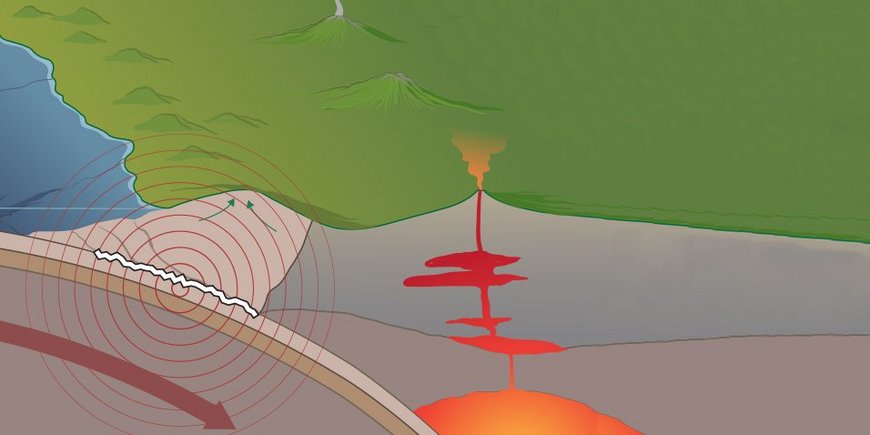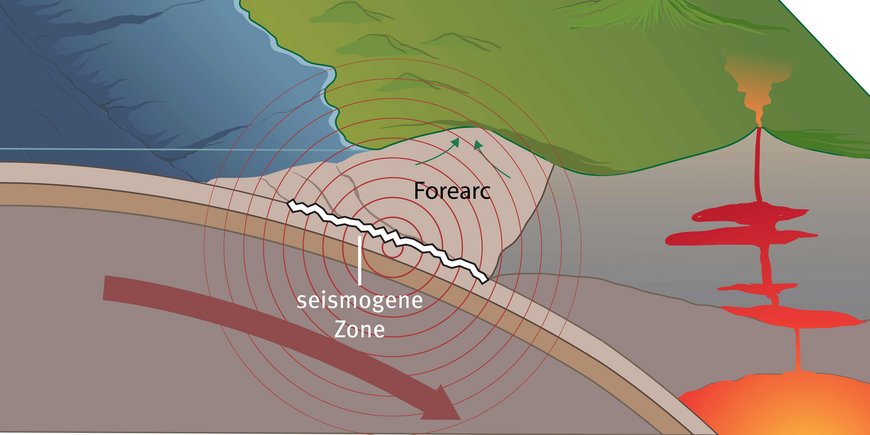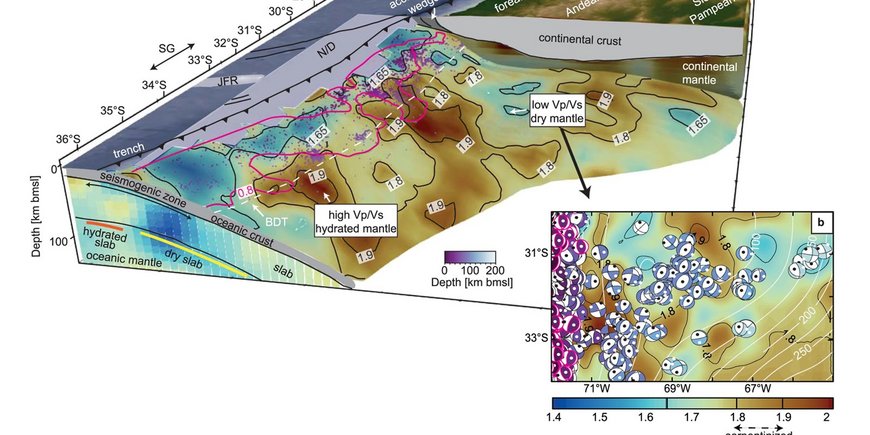Exactly which physical mechanisms are responsible for earthquake activity in the intermediate depths (50-300 km) of subduction zones is scientifically debated. But an understanding of this is immensely important, because the processes within oceanic plates dipping into the Earth's mantle cause the largest earthquakes worldwide. Constanza Rodriguez Piceda has therefore integrated geological, seismological and geodetic observation data from the southern part of the central Andes into models together with colleagues from the GFZ (section ’Basin Modelling' and 'Seismology') and the University of Potsdam. In particular, the seismic activity within the plates and on their surface is to be better understood. Research questions include the extent to which seismic activity at intermediate depths depends, for example, on the degree of hydration or is related to changes of the internal stresses in the oceanic plate. The study was published in Nature Communications Earth and Environment.
Seismic activity down to great depths
In so-called subduction zones, the relatively heavier oceanic plates slowly submerge under continental plates into the Earth's mantle. The rock is partially melted in the process. Earthquakes that occur within the dipping oceanic plate of subduction zones are a major source of global seismic hazards. This is the reason why, for example, the entire west coast of South America or the region along the Sunda Arc in Indonesia are affected by particularly severe earthquakes (magnitude >7). Seismic activity can reach very far - up to 800 km deep - into the Earth's mantle. This is remarkable because the pressure and high temperature conditions at such great depths should favor ductile deformation. This would be characterised by gradual deformations, whereby the cohesion of rock would remain and not cause frequent quakes. However, according to observations with seismometers, brittle rock failure, involving jerky fracturing and faulting, does occur, including earthquakes recorded at such great depths. At the Earth’s surface, such seismic activity is mostly not noticeable.
Physical mechanism responsible for seismicity widely debated
Exactly which physical mechanism is responsible for intermediate-depth seismicity (50‑300 km) is widely debated, with some studies attributing the failure to fluid-mediated processes that can weaken the rock. Consequently, regions with higher levels of hydration are expected to be more seismically active than dry regions. Other studies suggest that seismicity is due to changes in the internal stresses caused by variations in the dip angle of the subducting plate as it plunges into the deep mantle, without necessarily relying on fluid-mediated mechanisms.
Study area
One exceptional area to take a closer look into the drivers of slab seismic activity is the southern part of the central Andes in western South-America. Here the subduction angle changes from flat (<5°) in the north to steep (30°) in the south, and it has been the site of a considerable amounts of great earthquakes, such as the 2010 M8.8 Maule (Chile) and 2015 M8.2 Illapel (Chile) events. Another remarkable feature of this region is slab seismicity detected up to 300 km away from the Atacama trench (deep-sea channel), the subduction zone in the Pacific Ocean.
Hydrated regions seismically more active
To better understand the driving mechanisms behind these events, Constanza Rodriguez Piceda and colleagues from Sections 4.5 ‘Sedimentary Basin Modelling’ and 2.4 ‘Seismology’ as well as from the University of Potsdam integrated geological, seismological and geodetic observations into models. They used seismic tomography to map the regions of variable hydration states within the oceanic plate and the mantle of the overriding plate and compared it with the distribution of seismicity. They found that the amounts of crystalline water are highly variable from place to place and that this affects the spatial distribution of seismicity, with hydrated regions being more seismically active. In regions of low crystalline water contents, however, the shape of the subducting plate is the primary contributor to earthquake localization, with seismicity mainly taking place where the dip angle changes from flat to steep. Overall, this study successfully combined thermomechanical and geological approaches to help narrow down further the range of possible explanations for the seismic behavior in the area.
Original paper:
Rodriguez Piceda, C., Gao, Y., Cacace, M., Scheck-Wenderoth, M., Bott [Sippel], J., Strecker, M., Tilmann, F. (2023): The influence of mantle hydration and flexure on slab seismicity in the southern Central Andes. - Communications Earth & Environment, 4, 79.
https://doi.org/10.1038/s43247-023-00729-1
Images:
3D-Diagram 'Velocity ratio of different seismic waves'
Credit: CCBY 4.0 Rodriguez Piceda et al (2023); Communications Earth & Environment; doi.org/10.1038/s43247-023-00729-1
Link: https://media.gfz-potsdam.de/gfz/wv/pm/23/20230324_Subduction_CCBY.jpg
Subduction zone
Profile section illustrating the subduction of an oceanic crust beneath a continental crust. The oceanic crust is denser and thus heavier than the continental crust, so it is subducted under the continental crust when it meets. This process leads to the formation of deep-sea trenches, volcanoes, and earthquakes.
Credit: dwi – stock.adobe.com
Link: https://media.gfz-potsdam.de/gfz/wv/pm/23/20230324_Subduktion_AdobeStock-579567869.jpg












![[Translate to English:] Torsten Sachs in front of a climate station on a field](/fileadmin/_processed_/3/9/csm__TorstenSachs_bearbeitet_GS_4a1365ef84.jpeg)

![[Translate to English:] left image flood at the Ahrtal: image from above, several houses are flooded; left image:: Heidi Kreibich;](/fileadmin/_processed_/4/4/csm_Bild2_9af0130e9f.png)



![[Translate to English:] Start der Vega Rakete](/fileadmin/_processed_/6/4/csm_20231201-kachel_Vega-VV23-launch_ESA-CNES-Arianespace_706716b68c.jpeg)









![[Translate to English:] Poster exhibition at the Brandenburg Hydrogen Day at the GFZ, some participants in the foreground](/fileadmin/_processed_/6/5/csm_Erster_Brandenburgischer_Wasserstofftag_GFZ_402fcec95e.jpeg)
![[Translate to English:] Group picture of the participants](/fileadmin/_processed_/9/4/csm_20231108_CAWa-Workshop-Tashkent_Gruppenbild_99ea779d8a.jpeg)

![[Translate to English:] [Translate to English:] Hörsaal](/fileadmin/_processed_/e/6/csm_H%C3%B6rsal_e21ac645fb.jpeg)


![[Translate to English:] The Delegations in the Historic Library on the Telegrafenberg. In the back there are from left to right, the Dutch Ambassador for Germany, Ronald van Roeden, the Dutch Minister for Education, Culture and Science, Robbert Dijkgraaf and the scientific director of the GFZ, Susanne Buiter.](/fileadmin/_processed_/d/b/csm_Kachel-2_9eba4b4212.jpeg)

